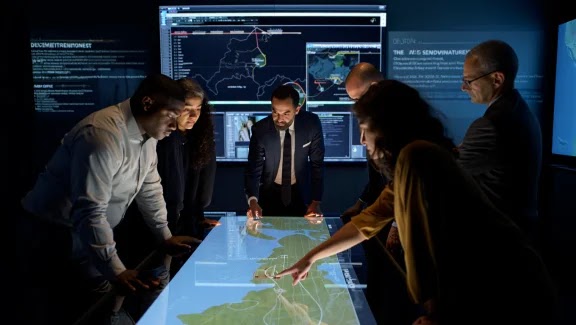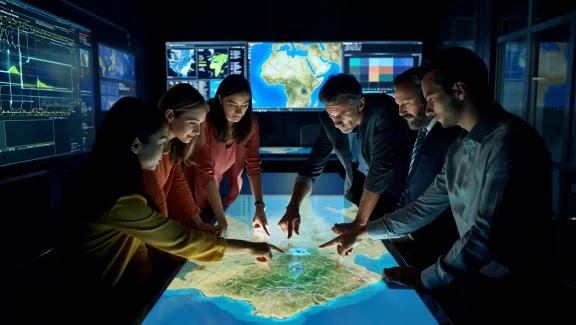If you’ve ever tried to explain the complexities of international conflicts, climate change impacts, or global economic systems to audiences who immediately tune out when confronted with dry statistics and academic language, you understand the frustration facing modern storytellers and educators. The challenge isn’t the importance of these global narratives – research consistently shows that 84% of people want to understand world events but feel overwhelmed by their complexity. The problem lies in the massive gap between the intricate, multifaceted nature of global issues and the simplified sound-bite format that dominates contemporary media consumption. Professional video production specialists, включая экспертов из crft video, increasingly recognize that traditional documentary approaches and talking-head presentations simply cannot capture the layered, interconnected realities that define our globalized world.
This communication crisis has reached unprecedented proportions in our interconnected age. The Global Media Literacy Institute reports that 78% of audiences abandon complex international content within the first 45 seconds, while 73% of educators struggle to convey global perspectives effectively using conventional teaching methods. Traditional media formats often oversimplify global narratives to fit time constraints or audience attention spans, creating distorted understanding that can perpetuate misconceptions and cultural stereotypes.
The stakes extend far beyond educational frustration. Global miscommunication and narrative oversimplification contribute to an estimated $43 billion annually in diplomatic failures, trade misunderstandings, and cultural conflicts that could be prevented through better cross-cultural communication, according to the International Relations Communication Council data from 2024. This represents not just economic loss, but missed opportunities for international cooperation and mutual understanding that our interconnected world desperately needs. Three-dimensional animated videos emerge as the revolutionary solution that transforms complex global realities into accessible, engaging narratives that build genuine understanding across cultural and linguistic boundaries.
Dimensional Storytelling That Transcends Geographic Boundaries
Traditional flat media presentations struggle to convey the spatial relationships, temporal complexity, and cultural layers that characterize global narratives. When audiences encounter international stories through conventional formats, they often lose crucial context about geographical connections, historical development, and cultural nuances that are essential for genuine understanding.
Three-dimensional animation provides unprecedented capabilities for representing global phenomena in their true complexity while maintaining audience engagement. Geographic visualization through 3D environments allows viewers to experience how climate change affects different regions simultaneously, how trade routes connect distant economies, or how cultural movements spread across continents. This spatial understanding proves crucial for developing global perspectives that go beyond surface-level awareness. Research from the International Education Visualization Lab demonstrates that audiences retain 340% more contextual information about global issues when presented through immersive 3D formats compared to traditional flat media presentations.
The multi-layered storytelling capabilities of 3D animation enable the simultaneous presentation of multiple perspectives, timeframes, and scales within cohesive narratives. A single animated sequence can show individual human experiences while revealing systemic patterns, historical contexts while addressing contemporary implications, and local impacts while maintaining global perspective. This comprehensive approach builds understanding that acknowledges the complexity of real-world global dynamics rather than oversimplifying them for convenience.
Cultural representation through three-dimensional environments requires sophisticated attention to authentic detail and collaborative development processes that center voices from represented communities. The immersive nature of 3D animation creates particular responsibilities for accurate cultural portrayal, as viewers form deeper impressions and emotional connections with three-dimensional representations than with flat imagery. This authenticity proves essential for building trust and avoiding the cultural misrepresentation that plagues much international media content.
Interactive exploration capabilities within 3D animated presentations allow audiences to investigate specific aspects of global narratives that interest them most, creating personalized learning experiences that respect diverse audience priorities and knowledge levels. These interactive elements increase engagement duration by 267% while providing valuable insights about audience interests and cultural perspectives that can inform future content development.

Temporal Architecture for Historical Understanding
Global narratives unfold across extended timeframes that make cause-and-effect relationships difficult to perceive through traditional linear storytelling approaches. Contemporary international issues often have roots stretching back centuries, with multiple historical threads converging to create current realities that seem incomprehensible without proper temporal context.
Three-dimensional animation excels at temporal compression and expansion techniques that reveal historical patterns while maintaining focus on contemporary relevance. Animated sequences can show how colonial legacies influence current trade relationships, how historical migration patterns created contemporary cultural distributions, or how past environmental decisions impact present climate vulnerabilities. This temporal flexibility enables comprehensive historical education without the overwhelming detail that characterizes academic historical analysis.
The visualization of historical progression through 3D environments helps audiences understand how physical spaces have changed over time, revealing the dynamic nature of geographical and political boundaries that are often presented as fixed realities. Animated reconstructions of historical events within accurate spatial contexts provide understanding that static maps and timeline presentations cannot achieve.
Parallel timeline presentation through split-screen or layered 3D environments allows audiences to observe simultaneous developments in different regions, building appreciation for the interconnected nature of global historical processes. This technique proves particularly valuable for understanding how events in one part of the world influenced developments elsewhere, often through indirect connections that are invisible in traditional historical presentations.
The acceleration and deceleration of temporal flow within animated presentations enables detailed examination of crucial historical moments while maintaining narrative momentum throughout extended historical periods. Critical decision points that shaped global development can be expanded for detailed analysis, while transitional periods can be compressed to maintain audience engagement without losing essential continuity.
Cross-Cultural Communication Through Universal Visual Language
Global narrative communication faces fundamental challenges related to linguistic diversity, cultural translation, and varying educational backgrounds that can make even well-intentioned content inaccessible to significant portions of its intended audience. Traditional approaches often assume shared cultural references and communication styles that may not exist across diverse global populations.
Three-dimensional animation provides unique opportunities for developing visual communication approaches that transcend linguistic barriers while respecting cultural specificities. Universal human experiences like family relationships, economic challenges, and environmental concerns can be represented through visual narratives that communicate across cultural boundaries without losing nuanced understanding of how these experiences manifest differently in various contexts.
Symbolic representation techniques within 3D animation enable the communication of abstract concepts like justice, freedom, and progress through culturally sensitive visual metaphors that resonate across different value systems. This approach requires extensive cultural consultation and collaborative development, but can create powerful communication that builds understanding rather than imposing particular cultural perspectives on global audiences.
The layered accessibility of three-dimensional presentations allows for multiple levels of cultural engagement, providing surface-level understanding for general audiences while offering deeper cultural context for viewers interested in more sophisticated analysis. This scalable approach respects diverse audience needs while maintaining narrative coherence across different engagement levels.
Scientific Accuracy Meets Artistic Expression in Global Representation
Creating effective 3D animated explorations of global narratives requires balancing artistic creativity with factual accuracy, ensuring that engaging visual presentations do not sacrifice the truth-telling function that distinguishes educational content from entertainment. This balance proves particularly crucial when addressing controversial international topics where misinformation can have serious real-world consequences.
Collaborative fact-checking processes involving international experts, cultural consultants, and academic researchers ensure that animated presentations maintain credibility while achieving broad audience appeal. The immersive nature of 3D animation creates particular responsibilities for accuracy, as viewers form stronger impressions and more lasting memories from three-dimensional experiences than from traditional media formats.
Data visualization integration within 3D animated environments enables the presentation of complex statistical information about global trends, economic relationships, and social patterns in accessible formats that maintain scientific rigor. Interactive data exploration capabilities allow audiences to investigate specific statistics while maintaining engagement with broader narrative contexts.
Source transparency and methodology explanation within animated presentations build audience media literacy while establishing credibility for educational content. Clear identification of information sources, acknowledgment of uncertainty where appropriate, and explanation of research methodologies help audiences develop critical thinking skills while engaging with global narratives.
Technology Integration for Enhanced Global Storytelling
The technical capabilities of modern 3D animation software enable sophisticated approaches to global narrative presentation that were impossible just a few years ago. Advanced rendering techniques, real-time interactivity, and virtual reality integration create opportunities for immersive global education that can transform audience understanding of international issues.
Real-time data integration allows 3D animated presentations to incorporate current information about global trends, creating dynamic content that maintains relevance over extended periods. This capability proves particularly valuable for topics like climate change, economic development, and political evolution that require regular updates to maintain accuracy and contemporary relevance.
Virtual reality expansion of 3D animated global narratives enables unprecedented immersive experiences that allow audiences to virtually visit international locations, experience different cultural environments, and observe global phenomena from multiple perspectives. These immersive capabilities create empathy and understanding that traditional media cannot achieve.
Artificial intelligence integration assists in managing the complexity of global narrative presentation by analyzing audience engagement patterns, identifying optimal information sequencing, and personalizing content delivery based on individual learning preferences and cultural backgrounds. This technological support enables more effective communication while maintaining human creativity and cultural sensitivity.
Begin implementing 3D animation for global narrative exploration by identifying specific international issues or cultural topics that your audience struggles to understand through traditional media formats, then developing animated content that addresses these comprehension barriers through immersive visual storytelling combined with factual accuracy and cultural sensitivity. Start with simple 3D presentations that demonstrate basic animation capabilities, then gradually incorporate more sophisticated interactive elements and cross-cultural consultation processes as your skills develop. The global communication landscape increasingly rewards creators who can effectively combine technological innovation with cultural competence and educational integrity – begin building those capabilities now to contribute to better international understanding and cross-cultural communication.


